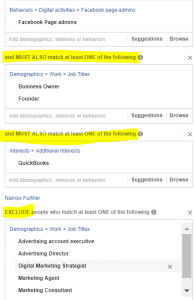First, a little bit of background info for those unfamiliar – Dubai is a relatively small and extremely diverse place. With a slightly over 3m population, it’s home to 200 nationalities thus a wild mix of languages, cultures, interests and buying habits. All that means that Facebook algorithm and advertisers  have to deal with high bias/high variance data while trying to figure out who is likely to click on an ad, engage with a post or buy a product. And thus a common complain “I seem to do everything right but Facebook ads don’t seem to work for me”
have to deal with high bias/high variance data while trying to figure out who is likely to click on an ad, engage with a post or buy a product. And thus a common complain “I seem to do everything right but Facebook ads don’t seem to work for me”
So, what advertisers could do to help the algorithm to help themselves?
It is not just pick up an interest targeting or demographics and put some creatives!
Use these powerful Facebook tools instead.
1. Audience Insights
Say you are an online fashion store. And you assume your prospects are interested in Shopping and Fashion. Let’s check it out.

Does that look like your what your ideal customer is interested in? If yes, then good for you – build it into an audience and start running ads. If not, that’s because of data variance and bias. Then what you supposed to do next? The following.
2. Audience Binders.
Will allow you to narrow down your audience by introducing AND and NO binders.
Say, you would like to target small business owners.
Your prospective audience could look like: facebook page admins NOT working in advertising AND ALSO interested in Quick Books (or similar – have the list ready)
So, here you go!

Caution: make sure your audience is not too narrow.
3. Custom Audiences
I believe by now everyone knows that you can put a pixel on your website to track visitors or upload your current customer’s list and target those.
But not everyone yet knows how to utilize the power of videos beyond obvious. As with website visitors you can track those who watch your video and target those who viewed the certain number of seconds of your video or watched a certain percentage of your video.

4. Look-a-like Audiences (LLA)
Remember that Facebook has about 10,000 data points on every one of us? What they do to build LLAs take common data points in a group of people – say your current customers – and find other people in the same country who share that same common parameter.

5. Funnels
Remember, people have a different level of familiarity with your brand. You should not “carpet bomb” all of them with the same ad.

Example of the Facebook funnel strategy
1. Start with the cold audience. Non-visitors, non-customers, unaware of your brand. Serve them 10-14 sec video showcasing your products and value propositions. Create an audience of those who viewed more than 75% of your video – as there’s clearly an interest in what you have shown them. Note that watching 10 seconds video is much more valuable engagement than a click or alike(1 second). Exclude 3 (or 7) days visitors and purchasers from that audience.
2. Retarget those with the Dynamic Product Ads.
3. Show those who viewed certain products form the same category and/or price brackets.
4. Those who added to cart by have not bought? Abandoned Cart audience. Reassure them – cash on delivery, favorable returns policy. Nudge them – last available in your size, discount of the 1st purchase.
5. Customers. Warm audience and if happy with their past experience just need to be reminded of you every once in a while. Perhaps, run a reach campaign with the new arrivals or promotions.
6. Netting

Balance out the number of people you are reaching with looking for hot prospects who are ready to convert. Blend in different objectives – engagement, traffic, conversions into your Facebook strategy.
Caution: back to small and diverse Dubai – certain groups of people generally engage with ads more than others and certain groups of people are larger thus cheaper. Facebook would prioritize showing your ads to these groups of people. Think of that when (if ever) doing Pay per Engagement campaigns (PPE) or page likes.
Final words of wisdom.
– Everything stated above is just a starting point and subject to testing.
– Everything in digital marketing is a subject to testing, everything must be challenged – every guru, every best practice, even [especially] what your Facebook [and Google] client success manager says.
– What you do on Facebook matters but what you do off Facebook matters more – make sure you offer consistent experience onsite once a user clicked on your ad.
– Facebook will not save you (in fact no digital marketing saves you) if customers don’t care about what you sell
– Just remember one thing: TEST > EVALUATE > SCALE > REPEAT!
 have to deal with high bias/high variance data while trying to figure out who is likely to click on an ad, engage with a post or buy a product. And thus a common complain “I seem to do everything right but Facebook ads don’t seem to work for me”
have to deal with high bias/high variance data while trying to figure out who is likely to click on an ad, engage with a post or buy a product. And thus a common complain “I seem to do everything right but Facebook ads don’t seem to work for me”






